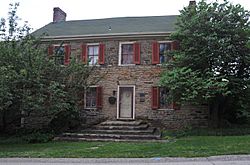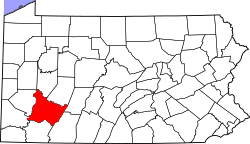North Huntingdon Township, Pennsylvania facts for kids
Quick facts for kids
North Huntingdon Township, Pennsylvania
|
|
|---|---|
|
Township
|
|

The Fullerton Inn, a historic site in the township
|
|

Map of Westmoreland County, Pennsylvania Highlighting North Huntingdon Township
|
|

Map of Pennsylvania highlighting
Westmoreland County |
|
| Country | United States |
| State | Pennsylvania |
| County | Westmoreland |
| Area | |
| • Total | 27.32 sq mi (70.75 km2) |
| • Land | 27.26 sq mi (70.60 km2) |
| • Water | 0.06 sq mi (0.15 km2) |
| Population
(2020)
|
|
| • Total | 31,847 |
| • Estimate
(2021)
|
31,757 |
| • Density | 1,125.50/sq mi (434.55/km2) |
| Time zone | UTC-5 (Eastern (EST)) |
| • Summer (DST) | UTC-4 (EDT) |
| FIPS code | 42-129-55128 |
North Huntingdon Township is a community located in Westmoreland County, Pennsylvania, in the United States. It is a type of local government area called a township. In 2020, about 31,847 people lived there.
Contents
History of North Huntingdon Township
How the Township Began
North Huntingdon Township got its name from the Earl of Huntingdon in England. It was first established as Huntingdon Township on April 6, 1772, in Pennsylvania.
The original Huntingdon Township was quite large. It covered about 26 square miles (67 km2). If you stretched out all the roads in the township, they would reach from North Huntingdon all the way to Cleveland, Ohio!
Over time, the original Huntingdon Township was divided. It was split into North Huntingdon, East Huntingdon, South Huntingdon, and Sewickley townships. Westmoreland County, where North Huntingdon is located, also formed other townships around this time.
Early Native American Tribes
Before European settlers arrived, many Native American tribes lived in this area. The Alligewe Indians are thought to be the first people here. Later, tribes like the Shawnee, Seneca, Cornplanter, and Lenni Lenape (also known as Delaware) lived in the region.
The first white person to enter this territory was Arnold Viele. He was a Dutch trader from Albany, New York, who arrived in 1662. He wanted to set up trading posts closer to other communities. He even convinced the Shawnee tribe to move closer to the Potomac and Susquehanna Rivers. Other early settlers included James Le Tort, Andrew Montour, Conrad Weiser, and George Croghan.
European Settlers and Their Communities
Many different groups from Europe settled in this area. Two main groups were German and Scottish-Irish immigrants. By the late 1670s, North Huntingdon Township was settled from both its eastern and western sides.
The German settlers mostly lived in the eastern part of the township. Their schools were run by the Lutheran church. These schools taught only in the German language.
The Scottish-Irish settlers were mostly Presbyterian. They settled more in the western areas. These areas included Circleville, Cavitt's Mills, and Robbin's Station.
Early Schools and Homes
The settlers wanted their children to get an education. Farmers would donate land so schools could be built close to home. These early schools were simple, made from logs with a clapboard roof.
Birch Spring School was the first school in the township. It was built in 1782. People also called it Master Jack's school, after its first teacher. Teachers back then only needed basic reading, writing, and math skills. They also had to know how to fix quill pens and use birch rods for discipline.
Another school called Fairview was built in 1816. This school served the eastern part of the township. Master Jack's school served the western part. Today, Norwin Middle School is located in this area.
The homes built by these settlers were also very simple. They were usually about 10 feet (3 meters) high with just one room and one window. They used mud to help insulate their homes against the cold winters. Chairs were made from logs, and beds were stuffed with hay or straw. Instead of a chimney, there was a hole in the roof to let out cooking smoke.
Population Growth Over Time
About a hundred years after the first German and Scottish-Irish settlers, the township's population was recorded. In 1860, about 3,000 people lived there.
By 1980, North Huntingdon Township had grown a lot. It was the second-largest community in Westmoreland County, with 31,517 residents. In 2000, the population was 29,123 people. The 2020 census showed the population was 31,847.
Historic Places
Two important historic buildings in North Huntingdon Township are listed on the National Register of Historic Places. These are the Fullerton Inn and the Andrew and Jennie McFarlane House.
Geography of North Huntingdon Township
North Huntingdon Township covers about 27.4 square miles (70.9 km2). Most of this area is land, with a small amount of water.
Major roads cross through the township. These include the Pennsylvania Turnpike (also known as Interstate 76) and Lincoln Highway (US 30). The southwestern part of the township also borders the Youghiogheny River for about 1.5 kilometers.
Population Information
| Historical population | |||
|---|---|---|---|
| Census | Pop. | %± | |
| 1970 | 29,443 | — | |
| 1980 | 31,517 | 7.0% | |
| 1990 | 28,158 | −10.7% | |
| 2000 | 29,123 | 3.4% | |
| 2010 | 30,609 | 5.1% | |
| 2020 | 31,847 | 4.0% | |
| 2021 (est.) | 31,757 | 3.8% | |
| U.S. Decennial Census | |||
In 2000, there were 29,123 people living in North Huntingdon Township. There were 11,216 households and 8,625 families. The population density was about 1,065 people per square mile.
The average household had 2.56 people. The average family had 2.96 people.
About 21.8% of the population was under 18 years old. About 17.7% of the population was 65 years or older. The average age in the township was 42 years.
See also
 In Spanish: Municipio de North Huntingdon para niños
In Spanish: Municipio de North Huntingdon para niños

